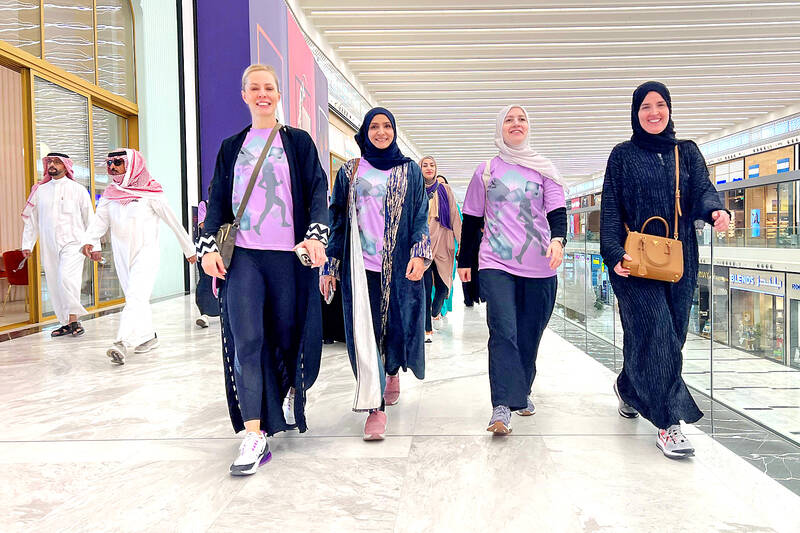The shops have not yet opened, but the air-conditioned concourse of a Riyadh shopping mall is crowded anyway — a haven for walkers and joggers grateful for somewhere cool to exercise.
The early-morning crowd includes 55-year-old engineer Mohammed Sultan, in a white T-shirt and black trainers, doing laps around the mall trailed by his niqab-wearing wife.
“It’s too hot outside to exercise. The weather here is cold and does not cause thirst,” Sultan says, noting that even in October, the end of the hot period in Saudi Arabia, daytime temperatures can still approach 40 degrees Celsius.

Photo: AFP
“Walking in gyms (on a treadmill) is very boring,” he adds with a laugh.
It is a scene replicated daily in malls across the Saudi capital, highlighting how a growing interest in physical fitness in the Gulf kingdom has collided with a dearth of suitable spaces for working out.
Long popular in the US, another car-centric country with an obesity problem, mall-walking is increasingly becoming a Saudi sport.
Roughly one in five Saudi adults is obese, according to an in-depth study published by the World Bank last year that described the issue as “alarming.”
To help bring that percentage down, the Saudi Sports for All Federation now organizes races such as the Riyadh Marathon, which this year drew thousands of runners onto the capital’s streets.
But such events are fairly irregular, and new gyms sprouting up in Riyadh often charge steep fees — a turn-off for Saudis who spurn fancy machines and simply need space to stretch their legs.
Officials have begun work on a 135km Sports Boulevard in the capital featuring foot, cycle and horse-riding paths. However that project — billed by organizers as “a green spine through the city” with “cooling water features” and shaded football pitches — is still years from completion.
That makes malls “the only option” for many people — at least for now, says Australian expat Zuzana Kalous, who formed a women’s walking group in Riyadh in 2020 that meets four times per week in different shopping centers.
“The mall is safe for women, air-conditioned and controlled. No pollution, no dust, no traffic,” she says as more than 20 members of her group jog past storefronts one recent morning.
The contained environment also guarantees people can exercise even in less-than-ideal weather, like spring sandstorms or winter rains, says Saudi nutritionist Laila al-Rifai, a member of Kalous’s group.
“Commercial centers are the ideal solution to continue walking at any time of the day, at any time of year,” she says.
Hassan Merhi, a Lebanese fitness trainer based in Riyadh, encourages his clients to walk outdoors as much as possible, noting that most studies show it offers a better workout than staying inside.
“It helps burn fat faster and reduces stress,” he says.
But Batoul Zind al-Hadid, a 41-year-old from Syria, says a mall walk is “excellent for those who are still feeling out their first steps.”
Not only does it tend to be more social, with groups gathered together in the same space, it also allows her to stay on top of the latest fashion trends by studying the display windows.
It is, she says, “a more comprehensive and entertaining experience.”

The canonical shot of an East Asian city is a night skyline studded with towering apartment and office buildings, bright with neon and plastic signage, a landscape of energy and modernity. Another classic image is the same city seen from above, in which identical apartment towers march across the city, spilling out over nearby geography, like stylized soldiers colonizing new territory in a board game. Densely populated dynamic conurbations of money, technological innovation and convenience, it is hard to see the cities of East Asia as what they truly are: necropolises. Why is this? The East Asian development model, with

June 16 to June 22 The following flyer appeared on the streets of Hsinchu on June 12, 1895: “Taipei has already fallen to the Japanese barbarians, who have brought great misery to our land and people. We heard that the Japanese occupiers will tax our gardens, our houses, our bodies, and even our chickens, dogs, cows and pigs. They wear their hair wild, carve their teeth, tattoo their foreheads, wear strange clothes and speak a strange language. How can we be ruled by such people?” Posted by civilian militia leader Wu Tang-hsing (吳湯興), it was a call to arms to retake

Desperate dads meet in car parks to exchange packets; exhausted parents slip it into their kids’ drinks; families wait months for prescriptions buy it “off label.” But is it worth the risk? “The first time I gave him a gummy, I thought, ‘Oh my God, have I killed him?’ He just passed out in front of the TV. That never happens.” Jen remembers giving her son, David, six, melatonin to help him sleep. She got them from a friend, a pediatrician who gave them to her own child. “It was sort of hilarious. She had half a tub of gummies,

The wide-screen spectacle of Formula One gets a gleaming, rip-roaring workout in Joseph Kosinski’s F1, a fine-tuned machine of a movie that, in its most riveting racing scenes, approaches a kind of high-speed splendor. Kosinski, who last endeavored to put moviegoers in the seat of a fighter jet in Top Gun: Maverick, has moved to the open cockpits of Formula One with much the same affection, if not outright need, for speed. A lot of the same team is back. Jerry Bruckheimer produces. Ehren Kruger, a co-writer on Maverick, takes sole credit here. Hans Zimmer, a co-composer previously, supplies the thumping